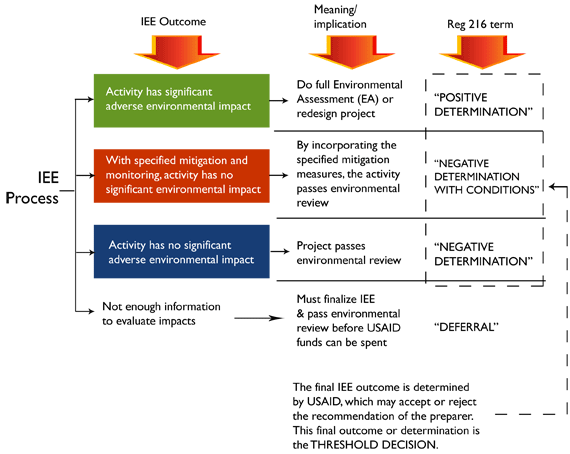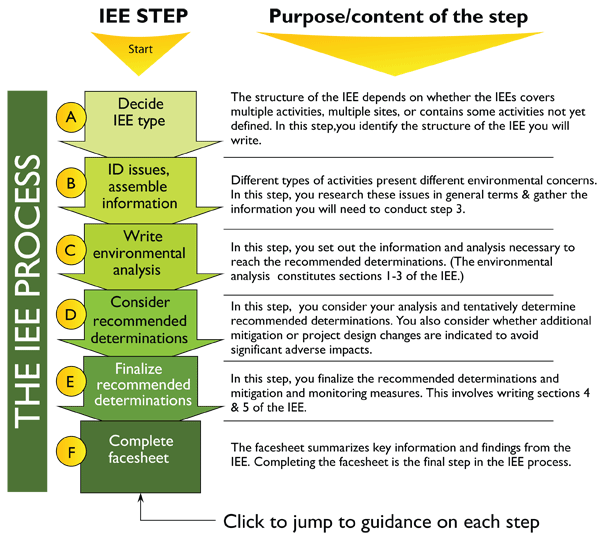Click on the diagram below to navigate.

Purpose of this step. Prepare the IEE. Summary of the purpose and content of the IEE. Description of IEE preparation steps.
Instructions. Your screening process did not rule out the possibility that your proposed activity (ies) had significant adverse environmmental impacts. Therefore, in Step 3, you determined that you needed to prepare an IEE and a compliance facesheet. Read this page to familiarize yourself with the:
Much of this information is also summarized in a powerpoint presentation.Subsequent pages provide assistance with each step of IEE preparation.
Purpose and outcomes of the IEEThe IEE is a first assessment of the reasonably foreseeable impacts on the environment of a proposed activity or activties. These impacts often depend on the environmental mitigation and monitoring activities specified in the IEE.The purpose of the IEE is to provide sufficient information and analysis to reach one of four conclusions (or threshold determinations) regarding the environmental effects of EACH proposed activity.
- For EACH activity, IEE preparers recommend one of these threshhold determination.
- The IEE also JUSTIFIES any categorical exclusions identified during the screening process
- These recommendations (and Categorical Exclusion justifications) are considered by the USAID Bureau Environmental Officer (BEO). The BEO can accept or reject the recommendation, or require further analysis.
As depicted in the diagram below, the threshold decision determines whether the activity can go forward, and under what conditions. For EACH ACTIVITY assessed in the IEE, one of four outcomes is possible.
| Background and description of Activities | Categorical exclusions are awarded because an activity, of its nature, presents inherently low risks of significant adverse impacts. (They can also be awarded because USAID does not have direct knowledge of or control over the activity.)In this section you must therefore provide sufficient information reqarding the NATURE of the activities to allow the BEO to evaluate whether a Categorical Exclusion is justified. In general, this section should not require more than 1-2 pages.The information should focus on:
|
|---|---|
| Justification for categorical exclusion request with citation to 22 CFR 216 | In this section, you need to explain how the proposed activities satisfy the requirements established by 22CFR216 for categorical exclusions. To do this, you must cite the relevant language in 22CFR216.2(c). Where 22CFR216 sets out a condition or restriction which must hold for the categorical exclusion to apply, this condition or restriction must be addressed. For example, 22CFR216.2(c)(2)(ii) established a categorical exclusion for "controlled experimentation exclusively for the purpose of research and field evaluation which are confined to small areas and carefully monitored." Your justification must therefore explain how the activity is confined/limited in area and how it it monitored. |
Purpose and outcomes of the IEE
The IEE is a first assessment of the reasonably foreseeable impacts on the environment of a proposed activity or activties. These impacts often depend on the environmental mitigation and monitoring activities specified in the IEE.The purpose of the IEE is to provide sufficient information and analysis to reach one of four conclusions (or threshold determinations) regarding the environmental effects of EACH proposed activity.
- For EACH activity, IEE preparers recommend one of these threshhold determination.
- The IEE also JUSTIFIES any categorical exclusions identified during the screening process
- These recommendations (and Categorical Exclusion justifications) are considered by the USAID Bureau Environmental Officer (BEO). The BEO can accept or reject the recommendation, or require further analysis.

Content of the IEE (Standard IEE Outline*)
(Click buttons for detailed content. Click here to download the full annotated outline.)
Activity/Preparer information
1. Background & Activity Description
1.1 Purpose & scope of the IEE
1.2 Background (Activity justification)
1.3 Description of Activities
(with reference to SO/results framework)
2. Country and Environmental Information
2.1 Locations Affected
2.2 Host country environmental policies and procedures
3. Evaluation of potential environmental impacts
4. Recommended Determinations and mitigation actions
4.1 Recommended threshhold decisions & conditions (& justification of categorical exclusions)
4.2 Mitigation, monitoring &evaluation commitments
*this standard outline is subject to change depending on IEE type, as described in step 1 of the IEE process (see below). Note that Regulation 216 does not specify IEE format or outline, but this outline is the standard adopted by Africa Bureau.

